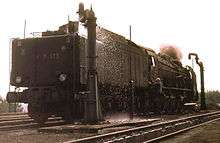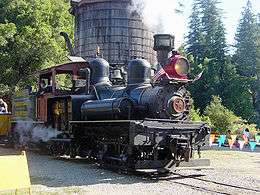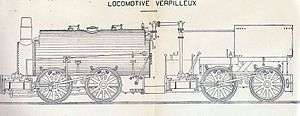Tender (rail)
A tender or coal-car is a special rail vehicle hauled by a steam locomotive containing its fuel (wood, coal, or oil) and water. Steam locomotives consume large quantities of water compared to the quantity of fuel, so their tenders are necessary to keep them running over long distances. A locomotive that pulls a tender is called a tender locomotive. Locomotives that do not have tenders and carry all their fuel and water on board the locomotive (itself) instead are called tank locomotives.
A brake tender is a tender that is heavy and used (primarily) to provide greater braking efficiency.
General functions
The largest steam locomotives are semi-permanently coupled by a drawbar to a tender that carries the water and fuel. The fuel source used depends on what is economically available locally. In the UK and parts of Europe, a plentiful supply of coal made this the obvious choice from the earliest days of the steam engine. Until around 1850 in the United States, the vast majority of locomotives burned wood until most of the eastern forests were cleared. Subsequently coal burning became more widespread, and wood burners were restricted to rural and logging districts.
Water supply


According to Steamlocomotive.com,[1]
By the mid-1800s, most steam locomotive tenders consisted of a fuel bunker (that held coal or wood) surrounded by a "U" shaped (when viewed from the top) water jacket. The overall shape of the tender was usually rectangular. The bunker which held the coal was sloped downwards toward the locomotive providing easier access to the coal. The ratio of water to fuel capacities of tenders was normally based on two water-stops to each fuel stop because water was more readily available than fuel. One pound of coal could turn six pounds of water (0.7 gallons) to steam. Therefore, tender capacity ratios were normally close to 14 tons of coal per 10,000 gallons of water.
The water supply in a tender was replenished at water stops and locomotive depots from a dedicated water tower connected to water cranes or gantries. Refilling the tender is the job of the fireman, who is responsible for maintaining the locomotive's fire, steam pressure, and supply of fuel and water.
Water carried in the tender must be forced into the boiler, to replace that which is consumed during operation. Early engines used pumps driven by the motion of the pistons. Later, steam injectors replaced the pump while some engines used turbopumps.
With track pans or water troughs
In the UK, the USA and France, water troughs (US track pans) were provided on some main lines to allow locomotives to replenish their water supply while moving. A 'water scoop' fitted under the tender or the rear water tank in the case of a large tank engine; the fireman remotely lowered the scoop into the trough, the speed of the engine forced the water up into the tank, and the scoop was raised once it was full.
The fuel and water capacities of a tender are usually proportional to the rate at which they are consumed, though there were exceptions. The Pennsylvania Railroad and the New York Central Railroad used track pans on many of their routes, allowing locomotives to pick up water at speed. The result was that the water tanks on these tenders were proportionally much smaller.
In the UK water troughs were used by three of the Big Four railways. The exception was the Southern Railway – mainly because the majority of the Southern's operations were based around short-distance commuter, suburban and rural services with frequent station stops where water could be taken on from water columns. The Southern's decision to electrify its routes into London with a third rail system also made the installation of water troughs impractical. Only on the former London and South Western Railway routes west of Salisbury, where long-distance express trains operated, was the lack of troughs a problem. Rather than install troughs the L&SWR (and the Southern) equipped its express locomotives with special high-capacity tenders with a water capacity of 4,000 gallons (18,200 l) running on a pair of twin-axle bogies. These were known to railwaymen as 'Water Cart' tenders.
Condensing tenders
Some locomotives were designed to recycle exhaust steam by condensing it into feed water. The principal benefit of this is conservation of water, but the thermodynamic efficiency of the engine is also increased, since much of the heat otherwise lost in the exhaust is used to preheat water injected into the boiler.[2] In some cases condensing was employed simply to improve visibility by eliminating clouds of exhaust.[2]
A primitive approach to condensation simply injected the spent steam into the tender tank, relying on the mass of water for cooling.[2] More sophisticated tenders, such as those used in the South African Railways Class 25 locomotives designed for service in the Karoo, replaced most of the water tank with a huge radiator, in which the steam was cooled and condensed. Exhaust steam, after passing through an oil separator, was conveyed to the tender, where it powered a low-pressure turbine used to drive the radiator fans. The steam then passed into the radiator. The condensate was injected into the boiler with another turbine-driven pump.[3] This was a quite complex bit of machinery, also requiring another turbine in the smokebox to provide the exhaust draft normally obtained by blowing the exhaust steam up the stack.[3] Eventually the SAR examples were converted to conventional locomotives by replacing the radiator with a long water tank.[4]
Fuel supply
A factor that limits locomotive performance is the rate at which fuel is fed into the fire. Much of the fireman's time is spent throwing wood or shoveling coal into the firebox of the locomotive to maintain constant steam pressure. In the early 20th century some locomotives became so large that the fireman could not shovel coal fast enough.[5] Consequently, in the United States, various steam-powered mechanical stokers (typically using an auger feed between the fuel bunker and the firebox) became standard equipment and were adopted elsewhere, including Australia and South Africa.
Tender design variants

In the early days of railroading, tenders were rectangular boxes, with a bunker for coal or wood surrounded by a U-shaped water jacket. This form was retained up to the end of steam on many coal-burning engines. Oil-burning engines substituted a fuel tank for the bunker. Variations on this plan were made for operational reasons, in attempts to economize on structure.
Vanderbilt tender
.jpg)
Sometime prior to 1901, Cornelius Vanderbilt III, whose great-grandfather founded the New York Central Railroad, invented a cylindrical tender, which was soon adopted by a number of American railroads with oil-burning and coal-burning locomotives.[1][6]
Compared to rectangular tenders, cylindrical Vanderbilt tenders were stronger, lighter, and held more fuel in relation to surface area. Railroads who were noted for using Vanderbilt tenders include:[1]
- Baltimore & Ohio
- Canadian National
- Grand Trunk Western
- Great Northern
- Southern Pacific
- Union Pacific
- New Zealand Railways Department (NZR AB class, NZR J class, NZR G class (1928)).
Whaleback tender
A form peculiar to oil-burning engines was the "whaleback" tender (also sometimes called a "turtle-back" or "loaf" tender). This was a roughly half-cylindrical form with the rounded side up; the forward portion of the tank held the oil, while the remainder held the water. This form was particularly associated with the Southern Pacific.[1]
Slopeback tender
.jpg)
In the United States, tenders with a sloped back were often used for locomotives in yard switching service, because they greatly improved the engineer's ability to see behind the locomotive when switching cars. The reduced water capacity was not a problem, as the tender's water tank could be frequently refilled in the rail yard.[1]
Corridor tender
.jpg)
For the introduction of the London and North Eastern Railway's non-stop Flying Scotsman service on 1 May 1928, ten special tenders were built with means to reach the locomotive from the train through a narrow passageway inside the tender tank plus a flexible bellows connection linking it with the leading coach. The passageway, which ran along the right-hand side of the tender, was 5 feet (1.52 m) high and 18 inches (0.46 m) wide. Further corridor tenders were built at intervals until 1938, and eventually there were 22; at various times, they were coupled to engines of classes A1, A3, A4 and W1, but by the end of 1948, all were running with class A4 locomotives.[7][8] Use of the corridor tender for changing crews on the move in an A4 loco is shown in the 1953 British Transport film Elizabethan Express, the name of another London-Edinburgh non-stop train.
Water cart

The water cart was a type of high-capacity tender used by the London and South Western Railway in England. Unlike the usual British six-wheel tender, it was a double-bogie design with inside bearings. This gave it a distinctive appearance because the wheels were very obvious.[9]
Canteen

An additional tender which holds only water is called a "canteen" or "auxiliary tender". During the steam era, these were not frequently used. Water tanks were placed at regular intervals along the track, making a canteen unnecessary in most cases. However, there were times that canteens proved economical. The Norfolk & Western used canteens with its giant 2-8-8-2 Y Class and 2-6-6-4 A Class locomotives on coal trains, timed freights, fast freights, and merchandise freights. Use of the canteen allowed one of the water stops to be skipped, allowing the train to avoid climbing a hill from a dead stop. Currently, Union Pacific uses canteens with its steam locomotives 844 and 3985 on excursion trains. Virtually all the trackside tanks were removed when steam locomotives were retired. Nowadays, fire hydrant hookups are used, which fills the tanks much more slowly. The canteens allow for greater range between stops.
Canteens were also used on the Trans-Australian Railway which crosses the waterless Nullarbor Plain.
In the United Kingdom a canteen was used on the preserved Flying Scotsman during enthusiast excursions in the late 1960s and early 1970s. The water troughs that had previously supplied long-distance expresses had been removed during dieselisation of the railway network. On 25 July 2009, "Bittern" made a 188-mile run from King's Cross to York non-stop using a second tender. As railways in Britain tend to be much shorter than those in the US, the canteen was not an economical proposition.
Fuel tender

Sometimes a tender will be used for a diesel locomotive. This is typically a tank car with a fuel line that connects to the locomotive and MU connections to allow locomotives behind the tender to be controlled remotely. The Burlington Northern used fuel tenders in remote territory where fuel was expensive. Diesel fuel could be bought cheaply and loaded into the tender. A common consist was two EMD SD40-2s with a tender between them. Some of the tenders survived the Burlington Northern Santa Fe merger but retain the black and green BN colors. The Southern Pacific also briefly experimented with fuel tenders for diesels. Some slugs have fuel tanks and serve as fuel tenders for the attached locomotives, especially those that are converted from locomotives that are retired due to worn-out diesels.
Union Pacific used fuel tenders on its turbines. These tenders were originally used with steam locomotives, then reworked to hold heavy "Bunker C" fuel oil. Fuel capacity was about 23,000 gallons (87,000 liters). When the turbines were retired, some of the tenders were reworked to hold water, and employed as canteens for steam locomotives.
Fuel tenders have also been the cause of controversy for railroads, in particular the Soo Line. In the late 1970s, the management of the railroad discovered that it was cheaper for them to fill their fuel tenders at Chicago, and then transport the fuel to Shoreham Wisconsin. Doing this avoided the railroad needing to pay extra taxes on the fuel, and the system was continued until the mid 1980s. When the states of Illinois and Wisconsin caught onto the railroad's actions, legislation was passed which charged the same over the road tax on the fuel movement over rail which was charged for truck drivers. Doing this completely negated the benefit of moving the fuel by way of the tenders, and Soo quietly withdrew the practice.
Tenders have also been developed to carry liquefied natural gas for diesel locomotives converted to run on that fuel.[10]
Brake tender
On British railways, brake tenders were low, heavy wagons used with early main line diesel locomotives. One or two were coupled next to the locomotive to provide extra braking power when hauling unfitted or partially fitted freight trains (trains formed from wagons not fitted with automatic brakes).[11][12] They were required as the lighter weight of the new diesel locomotives, compared to steam, meant that they had comparable tractive effort (and thus train hauling capacity) but less braking ability.[13] Originally intended to be used in North East England, where they were usually propelled (pushed) by the locomotive, and later used in other regions. On the Southern Region they were normally hauled behind the locomotive.[11]
The tender took the form of a hollow box, low enough to avoid obscuring the driver's view when pushed. The body was carried on a pair of former carriage bogies, which provided the automatic brakes.[14] The body was filled with scrap steel to raise the weight of the vehicle to 35½–37½ tons; consequently increasing the available brake force.[12] Four lamp brackets were provided at each end to display locomotive headcode discs describing the class of train – when propelled, the tender obscured the front of the locomotive, and hence the headcode.[15]
Introduced around 1964-5, they were taken out of use in the 1980s when the practice of using unfitted trains was discontinued.
Powered tender
Certain early British steam locomotives were fitted with powered tenders. As well as holding coal and water, these had wheels powered from the locomotive to provide greater tractive effort. These were abandoned for economic reasons; railwaymen working on locomotives so equipped demanded extra pay as they were effectively running two locomotives. However, the concept was tried again on the Ravenglass and Eskdale Railway's River Mite, and the Garratt locomotive may be seen as an extension of this principle. Powered tenders were also seen on the 2-8-8-8-2 and 2-8-8-8-4 locomotives in the United States, but these experiments were not considered successful. Powered tenders were used extensively on geared logging steam locomotives like the Shay locomotive, Climax locomotive, and Heisler locomotive where the steep grades and heavy trains necessitated the extra tractive effort.
Nowadays, slugs are used with diesel-electric locomotives. The slug has traction motors that draw electricity from locomotive's prime mover to provide extra traction.
German practice
In Germany, attention was given to ensuring that tender locomotives were capable of moderately high speeds in reverse, pushing their tenders. The numerous DRB Class 50 (2-10-0) locomotives, for example, were capable of 80 kilometres per hour (50 mph) in either direction, and were commonly used on branch lines without turning facilities.
A source of possible confusion with regards to German locomotives is that in German, Tenderlokomotive means a tank locomotive. A locomotive with a separate, hauled tender is a Schlepptenderlokomotive.
Tender-first operations
In some instances, particularly on branch lines having no turnaround such as a turntable or wye at the terminus point, locomotives ran in reverse with the tender leading the train. In such instances, a headlamp (US) or headcode lamps/discs were placed on the leading end of the tender. Locomotive crews often rigged a tarpaulin (or the locomotive's storm sheet, if available) from the rear of the cab roof to the front of the tender to provide protection from the wind and to prevent coal dust being blown into the cab. Tenders designed for more frequent tender-first workings were often fitted with a fixed cab panel and windows, providing an almost fully enclosed cab.
See also
References
- 1 2 3 4 5 "Steam Locomotive Tenders". Steamlocomotive.com. Retrieved 2008-08-20.
- 1 2 3 Ransome-Wallis, P. (1959). Illustrated Encyclopedia of World Railway Locomotives. New York: Hawthorn Books. pp. 314–315. Retrieved 2011-11-28.
- 1 2 Ransome-Wallis, P. (1959). Illustrated Encyclopedia of World Railway Locomotives. New York: Hawthorn Books. p. 472. Retrieved 2011-11-28.
- ↑ Durrant, A E (1989). Twilight of South African Steam (1st ed.). Newton Abbott, London: David & Charles. pp. 107–109. ISBN 0715386387.
- ↑ Bell, A Morton (1950). Locomotives (seventh ed.). London: Virtue & Co Ltd,.
- ↑ See Vanderbilt, Cornelius, "Locomotive Boilers" (1901), Baldwin Record of Recent Construction No. 23. This speech, delivered on January 8, 1901, to the junior members of the American Society of Mechanical Engineers, provides a detailed description of the design and construction of the boiler, as well as the results of numerous tests that Baldwin Locomotive Works had run.
- ↑ Boddy, M.G.; Fry, E.V.; Hennigan, W.; Proud, P.; Yeadon, W.B. (July 1963). Fry, E.V., ed. Part 1: Preliminary Survey. Locomotives of the L.N.E.R. Potters Bar: RCTS. pp. 64–65.
- ↑ Boddy, M.G.; Neve, E.; Yeadon, W.B. (April 1973). Fry, E.V., ed. Part 2A: Tender Engines - Classes A1 to A10. Locomotives of the L.N.E.R. Kenilworth: RCTS. p. 68. ISBN 0-901115-25-8.
- ↑ "Drummond T9 "Greyhound" class 4-4-0". Semgonline.com. 2009-12-30. Retrieved 2012-03-16.
- ↑ "Fuel Storage - LNG Locomotive Tender Car". Energy Conversions, Inc. Retrieved 2008-08-20.
- 1 2 BR Standard Freight Wagons - A Pictorial Survey, David Larkin, D. Bradford Barton Ltd, 1975, p.61, ISBN 0-85153-240-3
- 1 2 Diesel Brake Tenders (Southern E-Group page) (Accessed 2009-03-15)
- ↑ Clough, David N. (2011). Hydraulic vs Electric: The battle for the BR diesel fleet. Ian Allan. p. 137. ISBN 978-0-7110-3550-8.
- ↑ "Modelling Diesel Brake Tenders". Archived from the original on 3 November 2011. Retrieved 3 November 2011.
- ↑ Paul Bartlett's Photographs. "Paul Bartlett's photos of the later form of diesel brake tenders (Accessed 2011-11-03)". Paulbartlett.zenfolio.com. Retrieved 2012-03-16.
External links
| Wikimedia Commons has media related to Steam locomotive tenders. |
| Wikimedia Commons has media related to Diesel brake tenders. |

